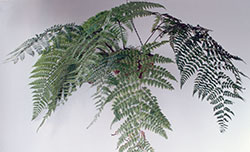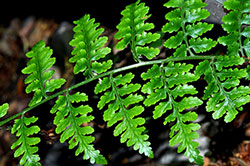Dryopteris wattsii
 Dryopteris wattsii in hanging basket, Photo: M.Fagg Dryopteris wattsii in hanging basket, Photo: M.Fagg |
 Dryopteris wattsii, Photo: David Tng Dryopteris wattsii, Photo: David Tng |
Reverend Watts' Fern
Dryopteris wattsii M.McKeown, Sundue & Barrington
 Dryopteris wattsii is a rare epiphytic fern belonging to the family Dryopteridaceae. Until recently, it was known as Revwattsia fragilis. It is named after its first collector, Reverend W.W.Watts, who specialised in Australian bryology. An attractive ornamental plant, its most distinguishing features include intricate bipinnate fronds growing up to 1–2m long and large, stocky rhizomes covered in dense brown scales. In its natural environment it grows in rotting tree hollows or within clumps of epiphytic ferns.
Dryopteris wattsii is a rare epiphytic fern belonging to the family Dryopteridaceae. Until recently, it was known as Revwattsia fragilis. It is named after its first collector, Reverend W.W.Watts, who specialised in Australian bryology. An attractive ornamental plant, its most distinguishing features include intricate bipinnate fronds growing up to 1–2m long and large, stocky rhizomes covered in dense brown scales. In its natural environment it grows in rotting tree hollows or within clumps of epiphytic ferns.
Dryopteris wattsii is endemic to the tropical mid-elevation rainforests of the Atherton Tablelands in north-eastern Queensland. Currently only six small populations have been discovered, with a combined total of less than a dozen individual plants. The narrow range and limited number of populations of this species, as well as its sensitivity to habitat disturbance, climate change and collecting predation, make this species vulnerable to extinction.
The introduction of Dryopteris wattsii into horticulture could contribute to the conservation of this fern. Spores are commercially available. Although Dryopteris wattsii requires a number of years to attain the large fronds found in its adult stage, the fern is attractive as a juvenile.
To cultivate Dryopteris wattsii the spores are sown into nutrient media mixed in gelling agent. A modified Hatcher's medium or modified Moore's medium, solidified with Phytagel, is recommended. While Dryopteris wattsii could also be grown by sowing the spores straight onto potting mix, growing it in the controlled environment of the nutrient media reduces contamination from bacteria and fungi and competition with mosses, lichens and other ferns. It can also be propagated vegetatively. If the fern develops more than one clump of frond-growing rhizomes, the extra clump can be cut off and planted in potting mix.
As an epiphyte, the ideal growing conditions for Dryopteris wattsii include high humidity, warm temperature, adequate shade, good ventilation and good drainage. Temperature of 25°–28° and humidity of 75–80% are recommended. Shade cloth and fan helps achieve the shade and ventilation. These conditions are most easily achieved in a fern house. Good drainage could be achieved by putting them in potting mix of one part decomposed pine bark to one part small pebbles, with regular watering to promote good steady growth (twice a day for a minute each). To avoid the fronds dipping into puddles, the pots should be elevated. Dryopteris wattsii needs generous space to grow. It should be put in reasonably large pot, with space between pots to allow the fronds to spread out. The plant needs repotting when it begins to crowd the pot.
Dryopteris wattsii is susceptible to insect pests common to other ferns, including scale insects, mealy bugs and black aphids. These pests can generally be removed manually. Alternatively, Pest Oil can be sprayed onto the fronds at half the normal concentration. In terms of fertilisers, the fern only needs general liquid fertiliser such as Peters Professional every 2 to 3 weeks, with occasional boost in nitrogen with fertiliser such as PowerFeed.
Shih-Wen Huang, Volunteer Botanical Training Program Participant 2018
Name meaning: Dryopteris wattsiiDryopteris - from the Greek words drys (an oak) and pteris (a fern) wattsii - referring to the botanist who originally described the plant, Reverend William Walter Watts (1856–1920) |
References:
Andrews, S.B. (1990). Ferns of Queensland. Brisbane. Queensland Department of Primary Industries.
Cargill, C. and Johnston, J. (2009). Final Report to the Australian Flora Foundation on the project The biology and cultivation of Revwattsia fragilis (Watts) D.L.Jones. Available at http://aff.org.au/wp-content/uploads/Cargill_Revwattsia_Final.pdf [Accessed 30 May 2018].
Hawkins, S. (2018). Australian National Botanic Gardens. Personal communication.
Jones, D. L. (1998). Revwattsia. Flora of Australia 48: Ferns, Gynosperms and Allied Groups. Melbourne: ABRS/CSIRO Australia.
Jones, D.L. (2017). Revwattsia. Flora of Australia. Australian Biological Resources Study, Department of the Environment and Energy, Canberra. Available at https://profiles.ala.org.au/opus/foa/profile/Revwattsia [Accessed 31 May 2018].
McKeown, M., Sundue, M. and Barrington, D. S. (2012). Phylogenetic analyses place the Australian monotypic Revwattsia in Dryopteris (Dryopteridaceae), PhytoKeys 14: 43–56.
Tng, D. (2017). Dryopteris wattsii (Dryopteridaceae), Leaf Whispering in the Tropics [blog], https://florafnq.wordpress.com/2017/01/18/dryopteris-wattsii-dryopteridaceae/ [Accessed 26 Jan. 2019].
![An Australian Government Initiative [logo]](/images/austgovt_brown_90px.gif)

